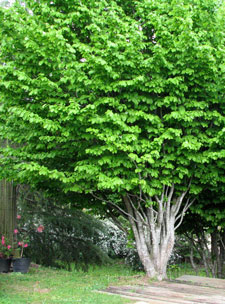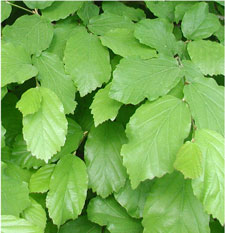Resource Library
Plant of the Week: Persian Ironwood
The University of Arkansas System Division of Agriculture does not promote, support or recommend plants featured in "Plant of the Week." Please consult your local Extension office for plants suitable for your region.
Plant of the Week
Persian Ironwood
Latin: Parrotia persica

Selecting a tree for the landscape is an important decision because it’s one you and your garden must live with for a long time.
The perfect tree will be tough, long lived, interesting at all seasons and be special – something designed to elicit envy from other gardeners visiting your home. If room for a medium-sized specimen exists, one to consider is Persian ironwood, Parrotia persica.
Persian ironwood is not an especially common tree in the nursery trade, but it’s available from nurseries trying to have cutting edge plant selections. This species grows as a 30- to 40-foot tall deciduous tree with low branching that gives it a rounded form nearly as wide as it is tall. It belongs to the witch hazel family and shares the low branching and leaf shape of that group.
As trees assume age, the bark begins to peel away in patches of gray, green, white and brown, making its wintertime form one of its most appealing periods.
The ovate leaves are 4 inches to 5 inches long, short-petioled and with an undulate leaf margin. They are pubescent and take on shades of orange and yellow in the fall. One author described this tree as having Fothergillia-like fall color, a compliment of the highest order.
Parrotia flowers appear in late winter as small reddish powder puff clusters of stamens. The tree lacks petals so appreciation of the flowers is reserved for those with a taste for simplicity of form and nuanced displays of color.
Persian Parrotia is native to northern Iran, north of Teheran on the north face of the Alborz Mountains, which provide part of the watershed for the Caspian Sea, the largest fresh water lake in the world.

The Alborz Range blocks rain clouds from moving into the rest of Iran, making it climatically similar to northern California. The region where Parrotia grows gets as much as 80 inches of rain a year. Until the recent completion of the Flora of China, Parrotia was considered monotypic, but now a second species has been described in east-central China. It’s listed as threatened and is not in cultivation.
Parrotia was botanically described in 1831 by Karl Anon Meyer, a Russian botanist-explorer who later became the director of the St. Petersburg Botanical Garden, from material he collected while exploring the region. He named it in honor of the Baltic German naturalist Friedrich W. Parrot who collected plants in the general region and became to first European to climb Turkey’s Mount Ararat in 1829.
Meyer took Parrotia to St. Petersburg, and from there, distributed seedlings to Kew in London in 1841. It arrived at Harvard Botanical Gardens in Boston in 1880. Most of the Parrotia grown in the United States are thought to have originated from this original introduction or subsequent collections sent to the Arnold Arboretum.
Parrotia has a medium growth rate and puts on about a foot of growth a year. It’s best in a fertile, slightly acidic soil with good drainage and a full sun location. Parrotia responds well to cultivation and will grow faster if given adequate water and nutrition. Though native to a high rainfall region it has good summertime drought resistance once established. It’s hardy from zones 5 to 8. No serious pest problems have been reported.
By: Gerald Klingaman, retired
Extension Horticulturist - Ornamentals
Extension News - May 11, 2007
The University of Arkansas System Division of Agriculture does not maintain lists of retail outlets where these plants can be purchased. Please check your local nursery or other retail outlets to ask about the availability of these plants for your growing area.